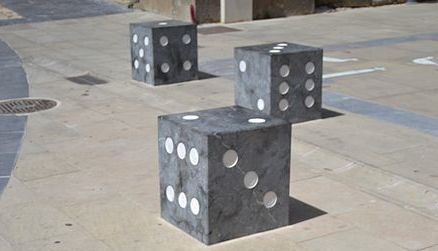Dice problems agaaaain
 What is the probability of getting a sum of 10 when rolling three fair six-sided dice?
What is the probability of getting a sum of 10 when rolling three fair six-sided dice?
Image credit: Wikipedia Jynus
This section requires Javascript.
You are seeing this because something didn't load right. We suggest you, (a) try
refreshing the page, (b) enabling javascript if it is disabled on your browser and,
finally, (c)
loading the
non-javascript version of this page
. We're sorry about the hassle.
7 solutions
This is by multinomial theorem, right ?
Log in to reply
It should be something like an OGF
My apologies for the delay in responding.
See http://www.whitman.edu/mathematics/cgt_online/section03.01.html. As Mr Coreale suggests these are generating functions; they are based on Newton's binomial theorem.
The possible combinations of 3 integers, each between 1 and 6 inclusive, which sum to 10, along with the number of possible permutations, are as follows:
(i) 1 , 3 , 6 ⟹ 6 permutations,
(ii) 1 , 4 , 5 ⟹ 6 permutations,
(iii) 2 , 2 , 6 ⟹ 3 permutations,
(iv) 2 , 3 , 5 ⟹ 6 permutations,
(v) 2 , 4 , 4 ⟹ 3 permutations,
(vi) 3 , 3 , 4 ⟹ 3 permutations.
This gives us a total of 2 7 outcomes out of the 6 3 = 2 1 6 outcomes that can occur without restrictions. Thus the desired probability is 2 1 6 2 7 = 8 1 .
Here is the list of permutation for getting a total of 10
6 3 1 == 6
6 2 2 == 3
5 4 1 == 6
5 3 2 == 6
4 4 2 == 3
4 3 3 == 3
Total == 27
So, Required probability = 27/216 = 1/8
Just count the permutations pivoting on one die when it's 1 the other two ought to be 9 there are 4/36 permutations for this.
when it's 2 the other two ought to be 8 - 5/36 permutations
when it's 3 the other two ought to be 7 - 6/36 permutations
when it's 4 the other two ought to be 6 - 5/36 permutations
when it's 5 the other two ought to be 5 - 4/36 permutations
when it's 6 the other two ought to be 4 - 3/36 permutations
By probability multiplication rule and the fact that on the pivoted dice each number has 1/6 to roll. we multiply all of the other two dice probabilities times 1/6 and then add up 27/216 = 1/8
Di ak maaram. Chamba la adto
guesss..........any easier methods plz.....
event is 27 and sample space is 6^3 so P= 27/6^3 or 1/8 which is the answer XD
The possible outcomes of a single die can be represented using the polynomial: x + x 2 + x 3 + x 4 + x 5 + x 6
Then the possible outcomes of three dice is representable as the third power of this polynomial:
x 1 8 + 3 x 1 7 + 6 x 1 6 + 1 0 x 1 5 + 1 5 x 1 4 + 2 1 x 1 3 + 2 5 x 1 2 + 2 7 x 1 1 + 2 7 x 1 0 + 2 5 x 9 + 2 1 x 8 + 1 5 x 7 + 1 0 x 6 + 6 x 5 + 3 x 4 + x 3
There's one way of getting 18, there are three ways of getting 17, and so on. The total number of ways the dice can appear is the sum of the coefficients, 216. There are 27 ways of getting 10.